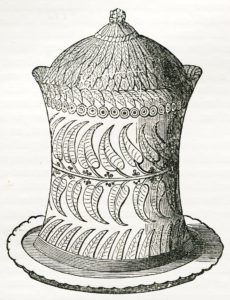Yorkshire Christmas Pie
 I have often said the more things change the more they stay the same. Perusing period cookbooks brings this to mind all the time. Between just finishing up to Christmas novella, where the Christmas feast features prominently and getting ready for Thanksgiving ourselves, I’ve had my nose in a number of cookbooks, both historical and modern, and came across this gem recently.
I have often said the more things change the more they stay the same. Perusing period cookbooks brings this to mind all the time. Between just finishing up to Christmas novella, where the Christmas feast features prominently and getting ready for Thanksgiving ourselves, I’ve had my nose in a number of cookbooks, both historical and modern, and came across this gem recently.
I don’t know if you’ve ever heard of the modern Tur-duck-en, a turkey stuffed with a duck stuffed with a chicken—yeah that’s a thing, really—but it is not nearly as modern as it might first seem. Apparently the wealthy could have enjoyed a similar dish during Regency times, called a Yorkshire pie.
Hannah Glasse, in her best-selling The Art of Cookery made Plain and Easy (1774), offers this recipe.
To make a Yorkshire Christmas-Pie.
FIRST make a good standing crust, let the wall and bottom be very thick; bone a turkey, a goose, a fowl, a partridge, and a pigeon, Season them all very well, take half an ounce of mace, half an ounce of nutmegs, a quarter of an ounce of cloves, and half an ounce of black-pepper, all beat fine together, two large spoonfuls of salt, and then mix them together. Open the fowls all down the back, and bone them; first the pigeon, then the partridge; cover them; then the fowls then the goose, and then the turkey, which must be large; season them all well first, and lay them in the crust, so as it, will look only like a whole turkey; then have a hare ready cased, and wiped with a clean cloth. Cut it to pieces, that is, joint it; season it, and lay it as close as you can on one side; on the other side woodcocks, moor game, and what sort of wild-fowl you can get. Season them well, and lay them close; put at least four pounds of butter into the pie, then lay on your lid, which must be a very thick one, and let it be well baked. It must have a very hot oven, and will bake at least four hours. This crust will take a bushel of flour. In this chapter you will see how to make it. These pies are often sent to London in a box, as presents; therefore, the walls must be well built.
(I always feel a little out of breath reading her recipes, since it seemed periods were in short supply during her day and commas had to suffice for most uses, but I digress.) Four pounds of butter and a bushel of flour for the crust. Mind boggling isn’t it?
Sometimes, after the pie cooled, a hot aspic sauce, calves’ foot jelly or similar jellied sauce was poured into the pie using a funnel. The pie would be allowed to cool again and ultimately be served cold. The actual meats used could variety depending on what was available to the cook, including game, veal, bacon, even truffles might find their way into a pie.
Special game pie dishes were mass produced by pottery houses, including Wedgwood. The dishes had an inner liner to hold the pie and an ornamental cover for presenting it at table. These were especially popular during the Regency years when the Napoleonic wars caused shortages of wheat for the pie crusts. Pies cooked in these dishes needed much less crust. I’m not sure if the engraving above represents a pie in a dish or in a very elaborate crush, though.
Read more about the Christmas feast here.
Watch a video that includes preparing a Yorkshire Pie in a period kitchen.
If you’ve enjoyed this post, you might also enjoy:

Maria, I have a Pinterest board called Historical Cooking & Recipes. I just had to pin this.
I just followed your board! Thanks!
Very involved recipe! Can you imagine what their cholesterol numbers were like in the Regency period?
It boggles the mind doesn’t it?
OMG!!! That oven better be hot or someone will die from food poisoning. My poor stomach groaned just thinking about all that meat… whew! No wonder gout was so prevalent. After that meal… you’d be in a coma for sure. This was so interesting, thank you for sharing. Suddenly my plans for Thanksgiving seem even better. Thanks for all that you do for the followers of this website. I do so enjoy your posts. Have a blessed Thanksgiving holiday with friends and family. Blessings.
I’ve really wondered about the amount of food poisoning in the period. I’ve been through food service kitchen manager training and it boggles the mind how anyone survived!
Oh, my!!! Scary!!
I think I’ll stick with our Southern California family tradition of taking the leftover Thanksgiving turkey and making huge pans of turkey enchiladas–one pan with green sauce and one with red!!! Yum!! 😀
Happy Thanksgiving!!
~Susanne 🙂
Those sound good. We have a few go to recipes for leftovers. This year though, my grad student son who was back for the holiday made short work of them!
When I read recipes like these I often wonder how I would have coped. I’m cow’s milk intolerant. Imagine all that butter!! I’d be in a coma!!!
Then of course there would be the meat sweats!! No wonder most of them died young.
Great post!!!!
Yeah, folk with food intolerances had a rough time then for sure!